
Aquarius is an equatorial constellation of the zodiac, between Capricornus and Pisces. Its name is Latin for "water-carrier" or "cup-carrier", and its old astronomical symbol is (♒︎), a representation of water. Aquarius is one of the oldest of the recognized constellations along the zodiac. It was one of the 48 constellations listed by the 2nd century astronomer Ptolemy, and it remains one of the 88 modern constellations. It is found in a region often called the Sea due to its profusion of constellations with watery associations such as Cetus the whale, Pisces the fish, and Eridanus the river.

Argo Navis, or simply Argo, is one of Ptolemy's 48 constellations, now a grouping of three IAU constellations. It is formerly a single large constellation in the southern sky. The genitive is "Argus Navis", abbreviated "Arg". Flamsteed and other early modern astronomers called it Navis, genitive "Navis", abbreviated "Nav".
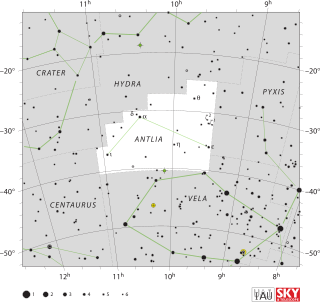
Antlia is a constellation in the Southern Celestial Hemisphere. Its name means "pump" in Latin and Greek; it represents an air pump. Originally Antlia Pneumatica, the constellation was established by Nicolas-Louis de Lacaille in the 18th century. Its non-specific (single-word) name, already in limited use, was preferred by John Herschel then welcomed by the astronomic community which officially accepted this. North of stars forming some of the sails of the ship Argo Navis, Antlia is completely visible from latitudes south of 49 degrees north.

Ara is a southern constellation between Scorpius, Telescopium, Triangulum Australe, and Norma. It was one of the Greek bulk described by the 2nd-century astronomer Ptolemy, and it remains one of the 88 modern constellations designated by the International Astronomical Union.
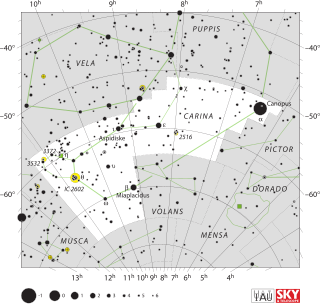
Carina is a constellation in the southern sky. Its name is Latin for the keel of a ship, and it was the southern foundation of the larger constellation of Argo Navis until it was divided into three pieces, the other two being Puppis, and Vela.

Fornax is a constellation in the southern celestial hemisphere, partly ringed by the celestial river Eridanus. Its name is Latin for furnace. It was named by French astronomer Nicolas Louis de Lacaille in 1756. Fornax is one of the 88 modern constellations.
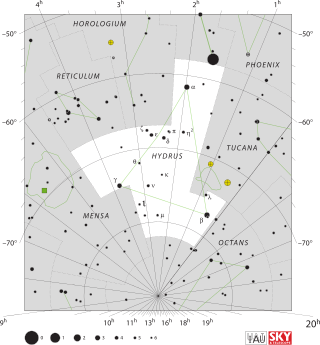
Hydrus is a small constellation in the deep southern sky. It was one of twelve constellations created by Petrus Plancius from the observations of Pieter Dirkszoon Keyser and Frederick de Houtman and it first appeared on a 35-cm (14 in) diameter celestial globe published in late 1597 in Amsterdam by Plancius and Jodocus Hondius. The first depiction of this constellation in a celestial atlas was in Johann Bayer's Uranometria of 1603. The French explorer and astronomer Nicolas Louis de Lacaille charted the brighter stars and gave their Bayer designations in 1756. Its name means "male water snake", as opposed to Hydra, a much larger constellation that represents a female water snake. It remains below the horizon for most Northern Hemisphere observers.
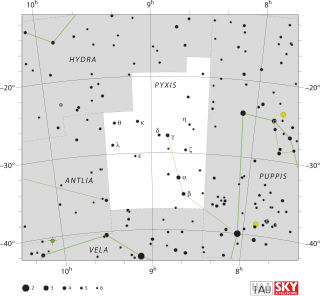
Pyxis is a small and faint constellation in the southern sky. Abbreviated from Pyxis Nautica, its name is Latin for a mariner's compass. Pyxis was introduced by Nicolas-Louis de Lacaille in the 18th century, and is counted among the 88 modern constellations.

Vela is a constellation in the southern sky, which contains the Vela Supercluster. Its name is Latin for the sails of a ship, and it was originally part of a larger constellation, the ship Argo Navis, which was later divided into three parts, the others being Carina and Puppis. With an apparent magnitude of 1.8, its brightest star is the hot blue multiple star Gamma Velorum, one component of which is the closest and brightest Wolf-Rayet star in the sky. Delta and Kappa Velorum, together with Epsilon and Iota Carinae, form the asterism known as the False Cross. 1.95-magnitude Delta is actually a triple or quintuple star system.

Norma is a small constellation in the Southern Celestial Hemisphere between Ara and Lupus, one of twelve drawn up in the 18th century by French astronomer Nicolas-Louis de Lacaille and one of several depicting scientific instruments. Its name is Latin for normal, referring to a right angle, and is variously considered to represent a rule, a carpenter's square, a set square or a level. It remains one of the 88 modern constellations.
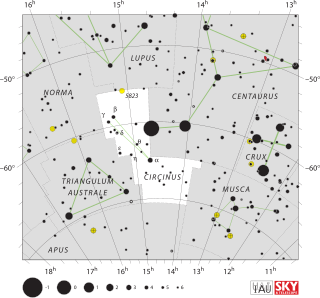
Circinus is a small, faint constellation in the southern sky, first defined in 1756 by the French astronomer Nicolas-Louis de Lacaille. Its name is Latin for compass, referring to the drafting tool used for drawing circles. Its brightest star is Alpha Circini, with an apparent magnitude of 3.19. Slightly variable, it is the brightest rapidly oscillating Ap star in the night sky. AX Circini is a Cepheid variable visible with the unaided eye, and BX Circini is a faint star thought to have been formed from the merger of two white dwarfs. Two sun-like stars have planetary systems: HD 134060 has two small planets, and HD 129445 has a Jupiter-like planet. Supernova SN 185 appeared in Circinus in 185 AD and was recorded by Chinese observers. Two novae have been observed more recently, in the 20th century.
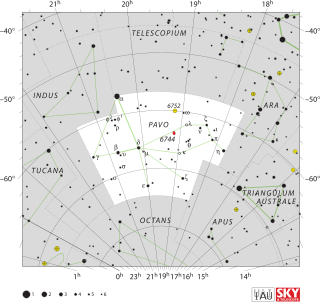
Pavo is a constellation in the southern sky whose name is Latin for 'peacock'. Pavo first appeared on a 35-cm (14 in) diameter celestial globe published in 1598 in Amsterdam by Petrus Plancius and Jodocus Hondius and was depicted in Johann Bayer's star atlas Uranometria of 1603, and was likely conceived by Plancius from the observations of Pieter Dirkszoon Keyser and Frederick de Houtman. French explorer and astronomer Nicolas-Louis de Lacaille gave its stars Bayer designations in 1756. The constellations Pavo, Grus, Phoenix and Tucana are collectively known as the "Southern Birds".

Messier 46 or M46, also known as NGC 2437, is an open cluster of stars in the slightly southern constellation of Puppis. It was discovered by Charles Messier in 1771. Dreyer described it as "very bright, very rich, very large." It is about 5,000 light-years away. There are an estimated 500 stars in the cluster with a combined mass of 453 M☉, and it is thought to be a mid-range estimate of 251.2 million years old.
HD 69830 is a yellow dwarf star located 41.0 light-years away in the constellation of Puppis. In 2005, the Spitzer Space Telescope discovered a narrow ring of warm debris orbiting the star. The debris ring contains substantially more dust than the Solar System's asteroid belt. In 2006, three extrasolar planets with minimum masses comparable to Neptune were confirmed in orbit around the star, located interior to the debris ring.

Omicron Velorum is a star in the constellation Vela. It is the brightest member of the loose naked eye open cluster IC 2391, also known as the ο Velorum Cluster.
NGC 2423-3 is a red giant star approximately 3,040 light-years away in the constellation of Puppis. The star is part of the NGC 2423 open cluster. The star has an apparent magnitude of 10 and an absolute magnitude of zero, with a mass of 2.4 times the Sun. In 2007, it was proposed that an exoplanet orbits the star, but this is now doubtful.

k Puppis is a Bayer designation given to an optical double star in the constellation Puppis, the two components being k1 Puppis and k2 Puppis.
HD 60532 b is an extrasolar planet located approximately 84 light-years away in the constellation of Puppis, orbiting the star HD 60532. This planet has a true mass of 3.15 times more than Jupiter, orbits at 0.77 AU, and takes 201.83 days to revolve in an eccentric orbit. This planet was discovered on September 22, 2008 in La Silla Observatory using the HARPS spectrograph. On this same day, the second planet in this system, HD 60532 c, was discovered in a 1:3 orbital resonance.
HD 60532 c is an extrasolar planet located approximately 84 light-years away in the constellation of Puppis, orbiting the star HD 60532. This planet has a true mass of 7.46 times more than Jupiter, orbits at 1.58 AU, and takes 607 days to revolve in an eccentric orbit. This planet was discovered on September 22, 2008 in La Silla Observatory using the HARPS spectrograph. On this same day, the second planet in this system, HD 60532 b, was discovered in a 3:1 orbital resonance.

Omicron Puppis (ο Puppis) is candidate binary star system in the southern constellation of Puppis. It is visible to the naked eye, having a combined apparent visual magnitude of +4.48. Based upon an annual parallax shift of 2.30 mas as seen from Earth, it is located roughly 1,400 light years from the Sun.

















